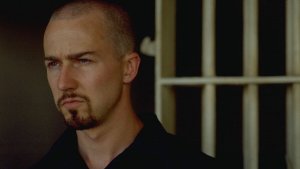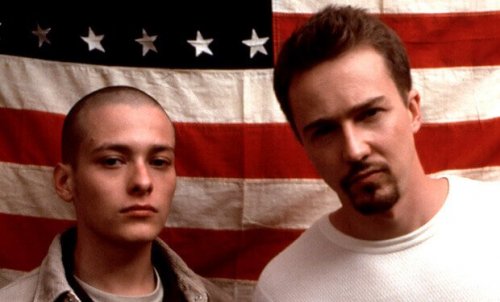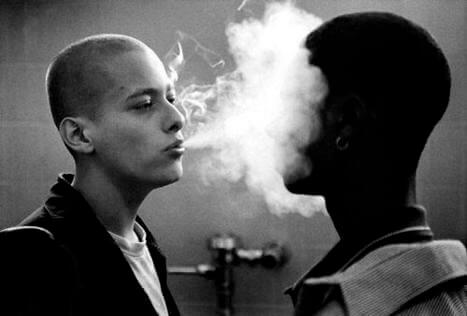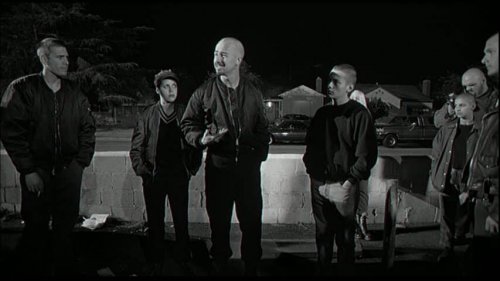American History X: What's Behind the Racism?

American History X hit the big screen in 1998. Tony Kaye directed this North American film starring Edward Furlong and a barely recognizable Edward Norton. The movie takes place in modern day United States. In the movie, immigration has changed the cities and caused some radical ideas to resurface again in the minds of young adults.
American History X opens with a black and white flashback scene. A young Neo-Nazi, Derek Vinyard, brutally murders two young African-Americans who were trying to rob his car. All the while, his mother and two sisters are asleep in their house, and his little brother is watching him in shock.
The movie then immediately jumps to the present, now in color. Young Daniel Vinyard, Derek’s brother, seems to be following in his brother’s footsteps when he turns in an essay about the book Mein Kampf. Professor Sweeney attempts to prevent Daniel from ruining his own life by giving him an unconventional homework assignment. The project is called “American History X” and Professor Sweeney expects Daniel to reflect on his brother’s actions.
A film with mixed reviews
The movie is quite interesting and the plot is well laid-out. However, the movie provoked contradictory reactions. Some critics wrote it off as melodramatic and emphasized how hard it was to empathize with Derek’s character. It’s difficult to believe that he is the same person after he’s released from jail. It’s also difficult to believe his mother and his sister’s behavior. Could it be that easy to forgive?
As the viewer, you forget the first brutal scene after a few minutes. That’s why it feels strange and difficult to believe that the Derek from the end of the movie is the same as the one from the beginning.
Norton’s portrayal of Derek is credible and amazing. Nevertheless, the character isn’t quite convincing, perhaps because of how different he is after being released from prison. It’s difficult to accept his new situation, his attempt to distance himself from his dark past.
Consequently, the movie casts a lot of doubt into the viewer’s mind and, in turn, loses credibility. In spite of all that, it’s interesting to see the background of the two main characters and how the most vulnerable characters are manipulated. It also helps us understand to a certain extent why this type of hate exists in society today.
In black and white scenes from the past and scenes in color that take place in the present, you discover why Derek ended up in jail and why he was released. This movie touches on the way that ideas are passed down from one generation to the next. It makes you think about the nature of your own prejudices.

Immigration and racism
Every day we grow more used to walking around town and finding people from different backgrounds, religions, cultures, etc. However, no matter how much you try to avoid them, there are a lot of prejudices surrounding different cultures. These prejudices are deeply rooted in our society and institutions. They’re very difficult to eradicate.
Every community has a cultural identity and we all like feeling like we’re part of something. It’s normal to defend your customs, language, and culture. We want what’s “ours” to endure. We hope that the things our parents and grandparents have shared with us won’t disappear. That’s why, when you feel like what is “yours” or “ours” is threatened, conflicts arise. In the worst of cases, you might rescue ideas or customs that trigger hate.
American History X places us in a working-class neighborhood. As time passes, the neighborhood becomes more and more diverse. Many of these new people are marginalized, something that often happens in our cities. This mass arrival provokes outrage among the original residents, who reject the immigrants with fear.
At the same time, the new arrivals reject the locals because of how they treat them, and this vicious cycle of hate repeats itself time and time again and makes integration and relationships impossible.

Derek meets a mentor
After losing his dad, Derek blames the black and Latino population for his death and basically all of society’s problems. From there, his perspective starts to change and he becomes friends with Cameron, a middle-aged Neo-Nazi.
Cameron sees Derek as a young, frustrated, and vulnerable man. However, he also has a lot of potential because he’s intelligent and extremely angry at minority groups. Cameron takes advantage of this situation and tasks him with leading his own “army.” This army is a group of skinheads like Derek who dedicate themselves to taking justice into their own hands.
As Derek his organizing his army, the black youth respond by organizing their own gangs. Both sides agree that violence is fundamental to their movement. The interesting thing is that Cameron, the brains of the operation, stays out of any altercation. He doesn’t want to get his hands dirty. Instead, he manipulates and uses the young men and organizes parties for them. His goal is for them to fully buy into his ideas and act violently of their own will.

American History X: From executioner to victim
Danny idolizes Derek in spite of the fact that he’s in jail for murder. The group of skinheads that he’s in charge of has gotten stronger and stronger and they consider Derek a hero. However, while his crew praises his actions, Derek becomes “black” in prison. The other prisoners abuse him. Thus, he tries to find his place among the other white people.
Derek joins a group of Neo-Nazis in prison but he quickly realizes that they don’t believe in anything. Their ideology isn’t very strong, it’s basically just a facade. At the same time, he works in the laundry room with a young African American man who tries to make the prison day-to-day a little less difficult. At first, Derek is resistant to his fellow prisoner’s ideas but, in the end, he becomes his ally.
In prison, Derek becomes the other. He experiences the hate and abuse that he inflicted on other people simply for the color of their skin first-hand. This, along with Professor Sweeney’s help, is what leads Derek to redemption. Obviously, he can’t revive the two people he murdered, but he can make sure his brother gets on the right path. When he’s released from jail, he has to confront the difficult reality that he left behind and make sure his brother doesn’t make the same mistakes he did.
Cultural identity and conflict
We all have ideas in our heads that are passed down from generation to generation. We are emotionally tied to our origins and don’t want our cultural identity to disappear. At the same time, social politics don’t make integration easy. When new cultures come onto the scene, conflict is inevitable. However, our history and the world are the fruit of migratory movement, cultural exchange, language exchange, etc.
American History X shows us the truth behind Derek’s ideas. He inherited them from his father, and Cameron reinforced them. Tragic, violent, and raw, American History X shows us the most radical consequences of a reality that is somewhat familiar to us.
“Hate is baggage. Life’s too short to be pissed off all the time.”
-Daniel Vinyard, American History X-
This text is provided for informational purposes only and does not replace consultation with a professional. If in doubt, consult your specialist.








